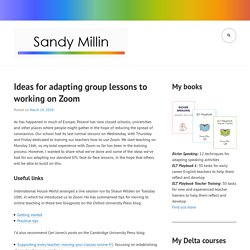

Teaching English online – opportunities and pitfalls. Sylvia Guinan, online English teacher, website editor and winner of the British Council TeachingEnglish blog award, walks us through the opportunities and pitfalls of teaching online in one of our top five articles of all time, illustrated by artist Jamie Johnson. There are many different things to consider when it comes to online teaching. The good news is that online teaching opens up new levels of creativity and opportunity for you as a teacher.
In a way, it drives you to surpass yourself and focus more on best practice as well as innovation. As for students, they deserve to be taught with 21st-century technology. Technology basics Many freelance teachers teach through Skype. Resources and content creation As for resources, the following sites have wonderful materials if you don’t feel like re-inventing the wheel. Beyond that, you may wish to supplement your basic course offerings, specialise for specific purposes or simply follow your own instincts and inspiration. Moving Your Classes Online #1. Published 13 March 2020 To help support all teachers who now have to teach from home due to the Coronavirus outbreak, we have created a series of blog posts with expert advice on how to move your classes online.

To begin, here’s a message from Eric Baber, Director of Professional Learning and Development, introducing the blog series. Moving your classes online: getting started It can be a daunting experience when you’re suddenly required to move all your face-to-face classes online with little or no advance notice, as has been happening to a number of teachers in various places around the world over the last month and more. In this blog post we’ll look at some basic steps to take that will hopefully smooth the transition. Moving your classes online #2. Published 13 March 2020 This is a follow up post from Ceri Jones who continues to share advice on how teachers can feel prepared with teaching students and moving classes online.

Ceri Jones is a teacher, trainer and materials writer based in Spain. She is part of the author team for our courses Eyes Open and Evolve as well as an online tutor for The Consultants-E. 1. Structuring your online classes Once you’ve set up the channels of communication so that you can inform your students about the changes to their classes, you need to think about how you’re going to structure those classes. Synchronous or asynchronous? Synchronous classes are “live” events, with the teachers and students meeting in an online space at an arranged time. Asynchronous classes are held in a shared online space, but the teacher and the students don’t need to be present at the same time. You may find that you want to use a combination of both. Video, audio or text? Video Audio Text 2. Teaching Children Online.
Published 18 March 2020 Are you a primary English teacher who is about to teach online for the first time?

Or, are you a primary teacher facing the dual challenge of teaching children online and preparing them for English exams? Or, maybe you already teach English online and are looking for extra ready-to-use ideas to engage and motivate children? David Valente shares advice on ways of teaching children online, keeping them engaged and focused on the task in hand. When primary teachers start teaching English online, they can sometimes go too far down the entertainment route with the aim of keeping children engaged. Teaching Your Adult English Class Online. Published 19 March 2020 Our blog series continues to help English teachers move their classes online in view of many institutions being closed due to the Covid-19 virus.

Today’s post is by Carol Rainbow, who offers suggestions for teaching your adult English class online. The virtual learning environment When teaching groups of adults online, planning for learning is slightly different to what you may have prepared for face to face class work. Ideally you need a virtual learning environment (VLE) such as the Cambridge Learning Management System (CLMS).
The VLE will offer an opportunity for the tutor to add tasks or activities to be completed by the learners. Most VLEs offer forum opportunities where learners and tutors can have asynchronous discussions, share ideas, post responses to tasks or just socialise. Tip – Remember the language that you are preparing the VLE in is not the learner’s native language, so keep it clear, simple and as straightforward as possible!
Using a Course Book. Good Enough Is Good Enough. Ideas for adapting group lessons to working on Zoom. As has happened in much of Europe, Poland has now closed schools, universities and other places where people might gather in the hope of reducing the spread of coronavirus.

Our school had its last normal lessons on Wednesday, with Thursday and Friday dedicated to training our teachers how to use Zoom. We start teaching on Monday 16th, so my total experience with Zoom so far has been in the training process. However, I wanted to share what we’ve done and some of the ideas we’ve had for our adapting our standard EFL face-to-face lessons, in the hope that others will be able to build on this. Useful links International House World arranged a live session run by Shaun Wilden on Tuesday 10th, in which he introduced us to Zoom. I’d also recommend Ceri Jones’s posts on the Cambridge University Press blog: Other useful posts: There’s a very active hashtag on Twitter called #coronavirusteaching, which you can view without having a Twitter account. I posted this tweet: Technical arrangements Chat box.